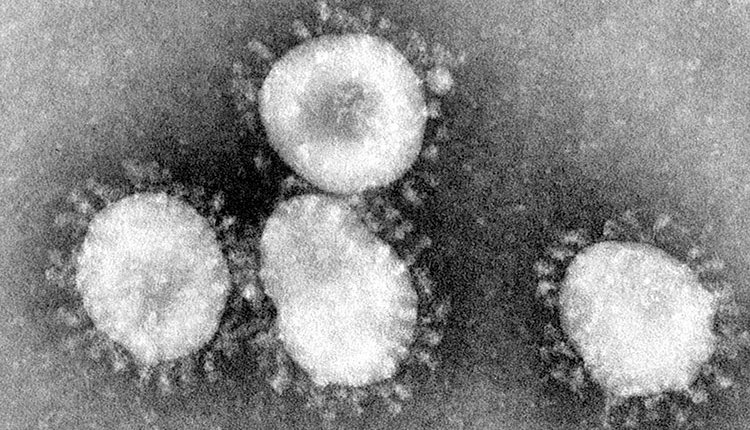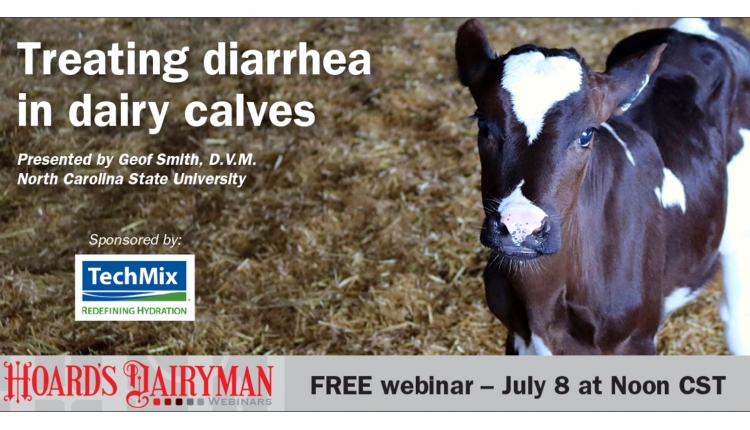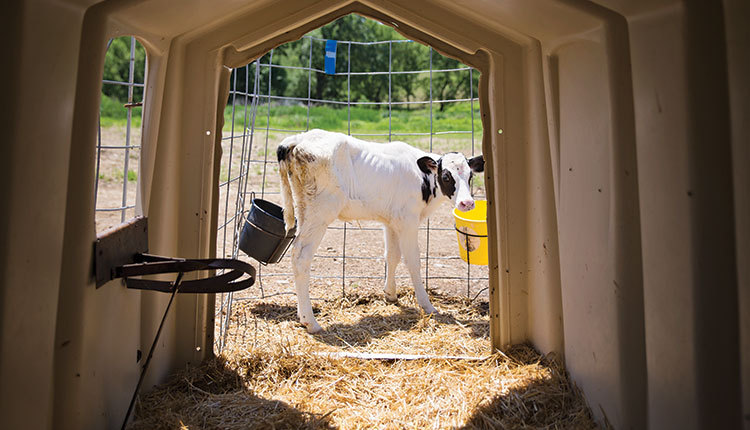The author is at the College of Veterinary Medicine, North Carolina State University, Raleigh.
Whether you are treating a cow for mastitis, uterine infection, diarrhea, or a number of other diseases, fluid therapy frequently is recommended. Many of these "sick" cows become dehydrated - meaning they have lost more water and fluids than they should.
Dairy cattle in particular are prone to rapid dehydration because they lose a large amount of their body water to milk production every day. Some people tend to avoid fluid therapy in cows because it can be more difficult compared to calves. (Larger fluid volumes are needed, the cow must be restrained, and proper fluid therapy can be time consuming.) However, in many sick cows, either oral or intravenous fluids are necessary and cannot be avoided.
How do you know?
The most accurate way of detecting dehydration in cattle is by looking at the position of the eyeballs. Normally, the eye should be right up against the bottom eyelid.
With the cow's head restrained, take your thumb and roll down the bottom eyelid. Normally, there should not be any gap or "space" between the eyelid and the eyeball. Dehydrated cows develop eyeball recession . . . their eyes begin to "sink" back into their head some. When you roll the bottom eyelid down with your thumb, you will notice a gap between the eyelid and the eyeball. Generally, the more sunken the eyes, the more severe the dehydration.
Another way to assess dehydration in cattle is to pinch the skin over the neck, twist it about 90 degrees, and let it go. In a normal cow, the skin should snap right back in place, while in dehydrated cows the skin returns much more slowly.
Here are some general guidelines for assessing dehydration in cattle
Mild dehydration:
Slight eyeball recession, skin tent slightly prolonged (2 to 4 seconds).
Moderate dehydration:
Eyes obviously sunken, skin tent obviously prolonged (4 to 8 seconds).
Severe dehydration:
Eyes severely sunken into orbit, skin remains tented indefinitely.
Oral fluids classically have been used to replace fluid losses in cows because they are cheap and easy to administer on-farm. One important point is that calves and cows should be receiving different electrolyte products. The blood in virtually all calves with diarrhea becomes more acidic. Therefore, we should be using oral electrolyte products that have alkalinizing agents such as bicarbonate or acetate in calves. These function to raise the pH of the blood, correcting the acidosis.
This does not happen in cows. In fact, most "sick" adult cattle either have a normal blood pH or a rise in pH (called an alkalosis). Therefore, they should not be receiving electrolytes that contain alkalinizing agents. It's a good idea to look at the ingredient list of the electrolyte powder you are using for your cows, and make sure you don't see bicarbonate on the list.
Cows generally need large amounts of water with sodium, chloride, and potassium. Therefore, we use electrolyte products that are basically salt with some potassium mixed with water. Ask your veterinarian next time he or she is at the farm if the product you have on hand is appropriate for adult cows.
Another option is to make your own oral fluids. It requires a little investment to get started, but in the end it can be very economical. You will need a digital laboratory scale that will weigh in grams and some feed grade salts which can be purchased from chemical supply companies or, sometimes, from feed stores. You need salt (sodium chloride), potassium chloride, and calcium chloride.
I weigh out 140 grams of salt, 25 grams potassium chloride, and 10 grams of calcium chloride. These can be combined together and stored in sealable individual plastic bags until you are ready to use them. Then they can be mixed with 5 gallons of water and pumped into a cow once or twice a day.
There are several different fluid delivery systems available. Two that I recommend are the Magrath pump (available from several on-line livestock supply companies) and the Nasco flexible cattle pump (available from Nasco). Both of these are designed to be used by a single person. They involve inserting a metal tube in the cow's mouth which can then be secured to the nose with a clamp. That way, the tube cannot slide in or out of the cow's mouth. The person can then let go of the tube and pump the 5 gallons of water into the cow before removing the nose clamp and taking the tube out. With either of these systems, one person can deliver 5 gallons of fluids within 2 to 3 minutes.
Administration of very large volumes of intravenous fluids is not common in adult cattle. Again . . . the cow must be restrained for an extended period of time, and the large volume of fluids necessary to correct the dehydration is expensive. However, among cows with moderate to severe dehydration, we can use hypertonic saline with better results than with oral fluids alone.
Hypertonic saline basically is salt water that is extremely concentrated. All solutions have what is referred to as an "osmolality." Osmolality simply refers to the concentration of particles dissolved into a particular solution. The osmolality of blood and regular fluids given intravenously to animals or humans is about 300, whereas hypertonic saline is 2,400. This means that hypertonic saline has sodium and chloride levels that are 7 to 8 times higher than what normally is found in blood.
How IVs work . . .
When we give this solution directly in the jugular vein of cattle - it dramatically increases the blood osmolality. The body really wants to maintain normal osmolality (300), so what happens is that water is sucked from the rumen and intestines into the blood. This works to rapidly rehydrate the cow.
Cows are very good candidates for hypertonic saline because they have a large water reservoir (rumen). So basically, we are raising the osmolality of blood (by giving hypertonic saline) and lowering the osmolality of the rumen (by pumping it with water). The two treatments together will cause a large movement of water from the rumen into other parts of the body.
You can purchase hypertonic saline commercially in1-liter bottles. It should be given to cattle at a dose of 2 milliliters (ml) per pound over a 4- to 5-minute period. This means that a 1,000-pound cow would need 2,000 ml (2 liters) of hypertonic saline given into the jugular vein over a 5-minute period.
After the fluid administration is complete, you should give the cow a supply of fresh water immediately. Most cows will drink 5 to 10 gallons over the next 10 minutes. Cows that do not drink water within 10 minutes of hypertonic saline should have 5 gallons of water pumped into their rumen.
Never give hypertonic saline alone without providing the cow fresh water to drink or pumping the rumen with water. This protocol has been shown to be very safe and is effective for the correcting dehydration in adult cattle. If necessary, it can be repeated for 2 to 3 days in a row.
In summary, fluid therapy should be an important part of your "sick cow" treatment protocols. Just administering antibiotics or other medications without fluids is not fully addressing the cow's problems. If you are not already administering oral fluids and hypertonic saline on a regular basis, work with your veterinarian to become more comfortable in assessing which cows are dehydrated and would benefit from fluid therapy.
Click here to return to the Animal Care E-Sources
090110_19
Whether you are treating a cow for mastitis, uterine infection, diarrhea, or a number of other diseases, fluid therapy frequently is recommended. Many of these "sick" cows become dehydrated - meaning they have lost more water and fluids than they should.
Dairy cattle in particular are prone to rapid dehydration because they lose a large amount of their body water to milk production every day. Some people tend to avoid fluid therapy in cows because it can be more difficult compared to calves. (Larger fluid volumes are needed, the cow must be restrained, and proper fluid therapy can be time consuming.) However, in many sick cows, either oral or intravenous fluids are necessary and cannot be avoided.
How do you know?
The most accurate way of detecting dehydration in cattle is by looking at the position of the eyeballs. Normally, the eye should be right up against the bottom eyelid.
With the cow's head restrained, take your thumb and roll down the bottom eyelid. Normally, there should not be any gap or "space" between the eyelid and the eyeball. Dehydrated cows develop eyeball recession . . . their eyes begin to "sink" back into their head some. When you roll the bottom eyelid down with your thumb, you will notice a gap between the eyelid and the eyeball. Generally, the more sunken the eyes, the more severe the dehydration.
Another way to assess dehydration in cattle is to pinch the skin over the neck, twist it about 90 degrees, and let it go. In a normal cow, the skin should snap right back in place, while in dehydrated cows the skin returns much more slowly.
Here are some general guidelines for assessing dehydration in cattle
Mild dehydration:
Slight eyeball recession, skin tent slightly prolonged (2 to 4 seconds).
Moderate dehydration:
Eyes obviously sunken, skin tent obviously prolonged (4 to 8 seconds).
Severe dehydration:
Eyes severely sunken into orbit, skin remains tented indefinitely.
Oral fluids classically have been used to replace fluid losses in cows because they are cheap and easy to administer on-farm. One important point is that calves and cows should be receiving different electrolyte products. The blood in virtually all calves with diarrhea becomes more acidic. Therefore, we should be using oral electrolyte products that have alkalinizing agents such as bicarbonate or acetate in calves. These function to raise the pH of the blood, correcting the acidosis.
This does not happen in cows. In fact, most "sick" adult cattle either have a normal blood pH or a rise in pH (called an alkalosis). Therefore, they should not be receiving electrolytes that contain alkalinizing agents. It's a good idea to look at the ingredient list of the electrolyte powder you are using for your cows, and make sure you don't see bicarbonate on the list.
Cows generally need large amounts of water with sodium, chloride, and potassium. Therefore, we use electrolyte products that are basically salt with some potassium mixed with water. Ask your veterinarian next time he or she is at the farm if the product you have on hand is appropriate for adult cows.
Another option is to make your own oral fluids. It requires a little investment to get started, but in the end it can be very economical. You will need a digital laboratory scale that will weigh in grams and some feed grade salts which can be purchased from chemical supply companies or, sometimes, from feed stores. You need salt (sodium chloride), potassium chloride, and calcium chloride.
I weigh out 140 grams of salt, 25 grams potassium chloride, and 10 grams of calcium chloride. These can be combined together and stored in sealable individual plastic bags until you are ready to use them. Then they can be mixed with 5 gallons of water and pumped into a cow once or twice a day.
There are several different fluid delivery systems available. Two that I recommend are the Magrath pump (available from several on-line livestock supply companies) and the Nasco flexible cattle pump (available from Nasco). Both of these are designed to be used by a single person. They involve inserting a metal tube in the cow's mouth which can then be secured to the nose with a clamp. That way, the tube cannot slide in or out of the cow's mouth. The person can then let go of the tube and pump the 5 gallons of water into the cow before removing the nose clamp and taking the tube out. With either of these systems, one person can deliver 5 gallons of fluids within 2 to 3 minutes.
Administration of very large volumes of intravenous fluids is not common in adult cattle. Again . . . the cow must be restrained for an extended period of time, and the large volume of fluids necessary to correct the dehydration is expensive. However, among cows with moderate to severe dehydration, we can use hypertonic saline with better results than with oral fluids alone.
Hypertonic saline basically is salt water that is extremely concentrated. All solutions have what is referred to as an "osmolality." Osmolality simply refers to the concentration of particles dissolved into a particular solution. The osmolality of blood and regular fluids given intravenously to animals or humans is about 300, whereas hypertonic saline is 2,400. This means that hypertonic saline has sodium and chloride levels that are 7 to 8 times higher than what normally is found in blood.
How IVs work . . .
When we give this solution directly in the jugular vein of cattle - it dramatically increases the blood osmolality. The body really wants to maintain normal osmolality (300), so what happens is that water is sucked from the rumen and intestines into the blood. This works to rapidly rehydrate the cow.
Cows are very good candidates for hypertonic saline because they have a large water reservoir (rumen). So basically, we are raising the osmolality of blood (by giving hypertonic saline) and lowering the osmolality of the rumen (by pumping it with water). The two treatments together will cause a large movement of water from the rumen into other parts of the body.
You can purchase hypertonic saline commercially in1-liter bottles. It should be given to cattle at a dose of 2 milliliters (ml) per pound over a 4- to 5-minute period. This means that a 1,000-pound cow would need 2,000 ml (2 liters) of hypertonic saline given into the jugular vein over a 5-minute period.
After the fluid administration is complete, you should give the cow a supply of fresh water immediately. Most cows will drink 5 to 10 gallons over the next 10 minutes. Cows that do not drink water within 10 minutes of hypertonic saline should have 5 gallons of water pumped into their rumen.
Never give hypertonic saline alone without providing the cow fresh water to drink or pumping the rumen with water. This protocol has been shown to be very safe and is effective for the correcting dehydration in adult cattle. If necessary, it can be repeated for 2 to 3 days in a row.
In summary, fluid therapy should be an important part of your "sick cow" treatment protocols. Just administering antibiotics or other medications without fluids is not fully addressing the cow's problems. If you are not already administering oral fluids and hypertonic saline on a regular basis, work with your veterinarian to become more comfortable in assessing which cows are dehydrated and would benefit from fluid therapy.
090110_19










